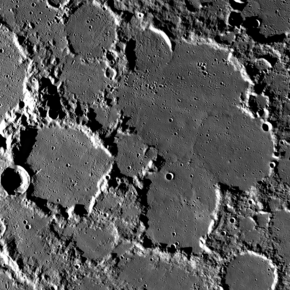Meton (crater)
Appearance
 | |
| Coordinates | 73°48′N 19°12′E / 73.8°N 19.2°E |
|---|---|
| Diameter | 122 km |
| Depth | 2.6 km |
| Colongitude | 338° at sunrise |
| Eponym | Meton |



Meton is a compound formation on the Moon that consists of several merged crater rings that have been flooded with lava, forming the remnant of a walled plain in the shape of a clover leaf. It is located near the northern lunar limb, and is viewed from a low angle and foreshortened. The crater Barrow is attached to the southwest rim. To the northwest is the crater Scoresby, and to the east are Baillaud and Euctemon.
Satellite craters
By convention these features are identified on lunar maps by placing the letter on the side of the crater midpoint that is closest to Meton.
| Meton | Latitude | Longitude | Diameter |
|---|---|---|---|
| A | 73.3° N | 31.3° E | 14 km |
| B | 71.2° N | 18.0° E | 6 km |
| C | 70.6° N | 19.0° E | 77 km |
| D | 72.2° N | 24.7° E | 78 km |
| E | 75.3° N | 15.3° E | 42 km |
| F | 72.0° N | 14.2° E | 51 km |
| G | 72.9° N | 28.4° E | 10 km |
| W | 67.4° N | 17.3° E | 7 km |
References
- Andersson, L. E.; Whitaker, E. A. (1982). NASA Catalogue of Lunar Nomenclature. NASA RP-1097.
{{cite book}}: Invalid|ref=harv(help) - Blue, Jennifer (July 25, 2007). "Gazetteer of Planetary Nomenclature". USGS. Retrieved 2007-08-05.
{{cite web}}: Invalid|ref=harv(help) - Bussey, B.; Spudis, P. (2004). The Clementine Atlas of the Moon. New York: Cambridge University Press. ISBN 978-0-521-81528-4.
{{cite book}}: Invalid|ref=harv(help) - Cocks, Elijah E.; Cocks, Josiah C. (1995). Who's Who on the Moon: A Biographical Dictionary of Lunar Nomenclature. Tudor Publishers. ISBN 978-0-936389-27-1.
{{cite book}}: Invalid|ref=harv(help) - McDowell, Jonathan (July 15, 2007). "Lunar Nomenclature". Jonathan's Space Report. Retrieved 2007-10-24.
{{cite web}}: Invalid|ref=harv(help) - Menzel, D. H.; Minnaert, M.; Levin, B.; Dollfus, A.; Bell, B. (1971). "Report on Lunar Nomenclature by the Working Group of Commission 17 of the IAU". Space Science Reviews. 12 (2): 136–186. Bibcode:1971SSRv...12..136M. doi:10.1007/BF00171763.
{{cite journal}}: Invalid|ref=harv(help) - Moore, Patrick (2001). On the Moon. Sterling Publishing Co. ISBN 978-0-304-35469-6.
{{cite book}}: Invalid|ref=harv(help) - Price, Fred W. (1988). The Moon Observer's Handbook. Cambridge University Press. ISBN 978-0-521-33500-3.
{{cite book}}: Invalid|ref=harv(help) - Rükl, Antonín (1990). Atlas of the Moon. Kalmbach Books. ISBN 978-0-913135-17-4.
{{cite book}}: Invalid|ref=harv(help) - Webb, Rev. T. W. (1962). Celestial Objects for Common Telescopes (6th revised ed.). Dover. ISBN 978-0-486-20917-3.
{{cite book}}: Invalid|ref=harv(help) - Whitaker, Ewen A. (1999). Mapping and Naming the Moon. Cambridge University Press. ISBN 978-0-521-62248-6.
{{cite book}}: Invalid|ref=harv(help) - Wlasuk, Peter T. (2000). Observing the Moon. Springer. ISBN 978-1-85233-193-1.
{{cite book}}: Invalid|ref=harv(help)
Wikimedia Commons has media related to Image:Lunar_crater_Meton.png.
